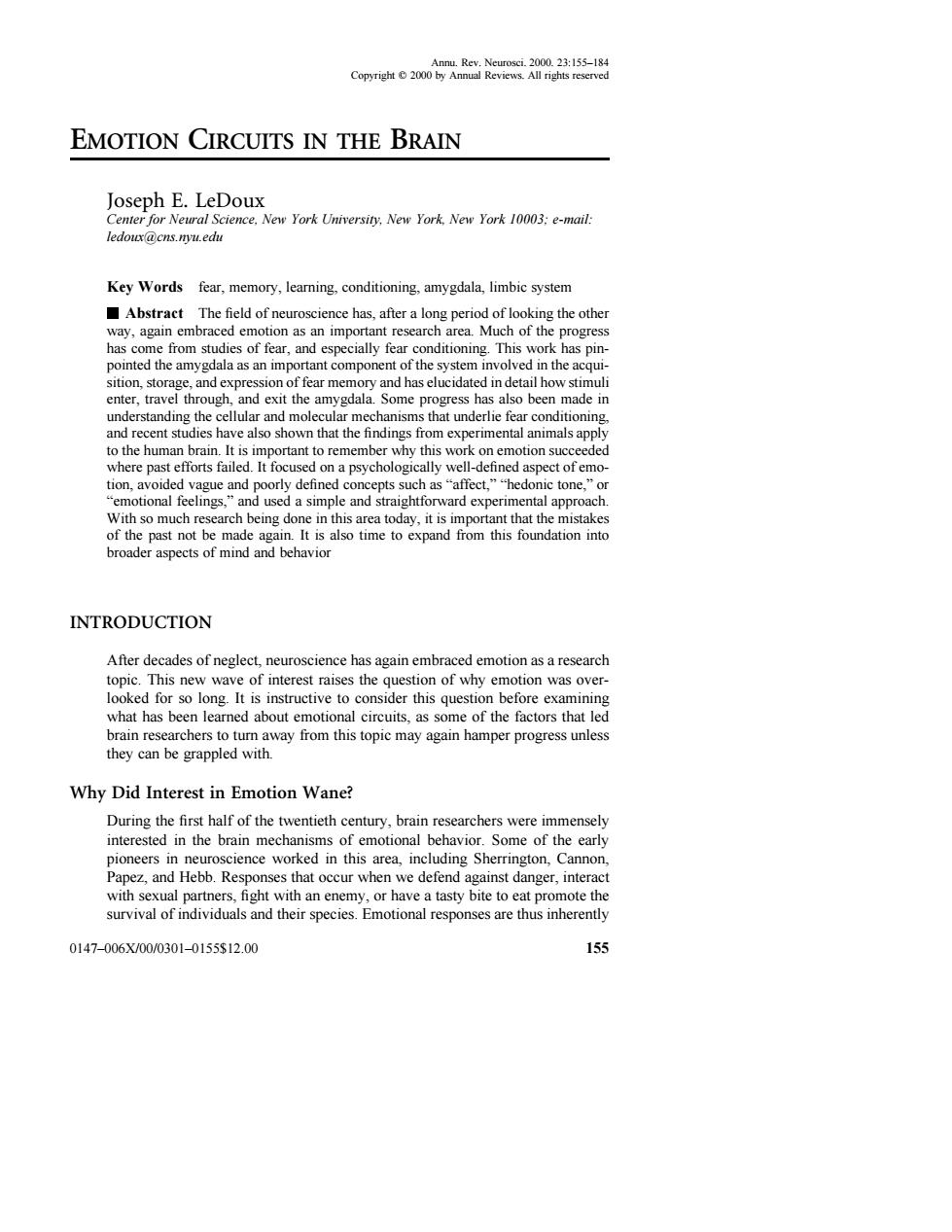正在加载图片...

Co2000 5 EMOTION CIRCUITS IN THE BRAIN Joseph E.LeDoux YorkUer Ne York k 00. @cns.nyu.edu Key Words fear,memory,leamning.conditioning.amygdala,limbic system ■Abstract The field has,after a long period of looking the othe has come from studies of fear.ande he system or th Ived in the acqu enter,travel through, and exit the amgdal Some progres has been made in emotion su motional feelings," used a simple and straightfor ward experimental approa of the past not be made palso time to expand from this foundation into broade INTRODUCTION After decades of neglect,neuroscience has again embraced emotion as a research long.It i ore e brain researchers to tum away from this topic mav again hamper progress unless they can be grappled with. Why Did Interest in Emotion Wane? During the first half of the twentieth century,brain r pioneers in neuroscience worked in this area,including Sherrington,Cannon. ez,and Hebb onses that occur when we defer tanger,intera 0147-006X/000301-0155S12.00 155 Annu. Rev. Neurosci. 2000. 23:155–184 Copyright q 2000 by Annual Reviews. All rights reserved 0147–006X/00/0301–0155$12.00 155 EMOTION CIRCUITS IN THE BRAIN Joseph E. LeDoux Center for Neural Science, New York University, New York, New York 10003; e-mail: ledoux@cns.nyu.edu Key Words fear, memory, learning, conditioning, amygdala, limbic system Abstract The field of neuroscience has, after a long period of looking the other way, again embraced emotion as an important research area. Much of the progress has come from studies of fear, and especially fear conditioning. This work has pinpointed the amygdala as an important component of the system involved in the acquisition, storage, and expression of fear memory and has elucidated in detail how stimuli enter, travel through, and exit the amygdala. Some progress has also been made in understanding the cellular and molecular mechanisms that underlie fear conditioning, and recent studies have also shown that the findings from experimental animals apply to the human brain. It is important to remember why this work on emotion succeeded where past efforts failed. It focused on a psychologically well-defined aspect of emotion, avoided vague and poorly defined concepts such as “affect,” “hedonic tone,” or “emotional feelings,” and used a simple and straightforward experimental approach. With so much research being done in this area today, it is important that the mistakes of the past not be made again. It is also time to expand from this foundation into broader aspects of mind and behavior INTRODUCTION After decades of neglect, neuroscience has again embraced emotion as a research topic. This new wave of interest raises the question of why emotion was overlooked for so long. It is instructive to consider this question before examining what has been learned about emotional circuits, as some of the factors that led brain researchers to turn away from this topic may again hamper progress unless they can be grappled with. Why Did Interest in Emotion Wane? During the first half of the twentieth century, brain researchers were immensely interested in the brain mechanisms of emotional behavior. Some of the early pioneers in neuroscience worked in this area, including Sherrington, Cannon, Papez, and Hebb. Responses that occur when we defend against danger, interact with sexual partners, fight with an enemy, or have a tasty bite to eat promote the survival of individuals and their species. Emotional responses are thus inherently